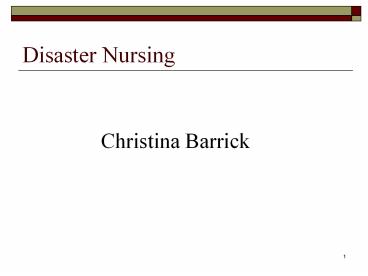Disaster Nursing - PowerPoint PPT Presentation
1 / 25
Title:
Disaster Nursing
Description:
Disaster Nursing Christina Barrick * * Objectives Describe examples of natural and manmade disasters. attack. Describe the different phases of a disaster. – PowerPoint PPT presentation
Number of Views:1944
Avg rating:3.0/5.0
Title: Disaster Nursing
1
Disaster Nursing
- Christina Barrick
2
Objectives
- Describe examples of natural and manmade
disasters. attack. - Describe the different phases of a disaster.
- Discuss the nurses role in managing the disaster
victim. - Compare the reactions of children and the
elderly. - Discuss the role of the nurse in primary,
secondary, and tertiary care. - Apply principles of triage to select situations.
- Describe the principles of disaster management.
3
What is a Disaster?
- Forces overwhelm a community.
- Services are compromised.
- Outside assistance is required.
4
Characteristics of Disaster Agents
- Predictability
- Frequency
- Controllability/Mitigation
- Time speed, duration
- Scope
- Intensity
- Community Implications
5
Manmade Disasters Terrorism
- D.O.D estimates that as many as 26 nations
possess chemical or biological agents. - 10 countries are believed to possess biological
agents as weapons - Attack can take many forms
- Aerosolized agents
6
Nuclear Attack
7
Nuclear and Radiological Attack
- Dirty Bomb
- Appeal to terrorists
- Availability
8
Natural Disaster Tsunami
9
Phases of a Disaster
- Pre-disaster
- Warning
- Impact
- Emergency
- isolation
- rescue
- remedy
- Recovery
10
Immediate Physical Management of the Disaster
Victim
- Validate what you hear
- Perform a thorough assessment
- Assess for other injuries/illnesses even when
symptoms are absent - Is the condition life-threatening
- What is past medical history?
- Do not ignore patient fears or complaints
11
Management of the Psychosocial Aspects of a
Disaster Victim
- Pre-disaster Preparations and Warning Phase
- reactions apathy to panic
- interventions mock drills, leadership
- important goal
- interventions mental health services
12
Management of the Psychosocial Aspects of a
Disaster Victim
- Impact and Emergency Phase
- reaction disaster syndrome
- Interventions prevent isolation, rumor control
13
Management of the Psychosocial Aspects of a
Disaster Victim
- Recovery Phase
- reaction
- interventions
14
Reactions of Children to a Disaster
- Developments level
- Familys reactions
- Separation anxiety
- School refusals
- Enuresis
- Guilt
15
Reactions of Children to a Disaster
- Interventions
- Research
- www.fema.gov/kids
16
Elderly Reactions
- Generally cope better
- Prob. related to chronic illness/resources
- Fear loss of independence
- Interventions
- assistance with clean up
- financial, legal, and tax info.
- refer to a support team
- refer to appropriate comm. agencies
17
Caregivers Reactions
- Same as Victim
- Role Strain
- Concerns over Personal Safety Family
- Possessiveness towards victims
- Nurse - parent identification with pediatric
victims - Interventions
- clear disaster plans disaster exercises
18
Criteria for Post Traumatic Stress Disorder
- The trauma is universally recognized
- Re-experience the trauma
- Demonstrate either emotional numbing or decrease
in normal events
19
Three Tier Triage System
- First Priority
- Second Priority
- Third Priority
20
Three Tier Triage System
- Special Cases
- pregnancies
- injured disaster personnel
- family of rescue worker
- agitated of violent patients
21
Role of the Nurse at the Disaster Site
- Insure safety
- First Aid
- Emergency care
22
Role of the Nurse in a Shelter
- Objective temporary means of caring
- Assessment
- Planing
- 24/7 nursing and ancillary coverage
- Supplies
- Implementation
- Evaluation
23
Role of the CHN in a Community Setting After a
Disaster
- Goal Achieve the best possible level of health
for persons in a community after a disaster - Primary Prevention
- Secondary Prevention
- Tertiary Prevention
24
Prevention Levels in Disaster Management
- Primary Prevention
- Secondary Prevention
- Tertiary Prevention
25
Principles of Disaster Management
- Prevent the disaster
- Minimize casualties
- Prevent further casualties
- Rescue the victims
- First aid
- Evacuate
- Medical care
- Reconstruction








![[PDF] Priorities in Critical Care Nursing 9th Edition Kindle PowerPoint PPT Presentation](https://s3.amazonaws.com/images.powershow.com/10087833.th0.jpg?_=20240729074)



![[Download ]⚡️PDF✔️ Medical-Surgical Nursing: Concepts for Clinical Judgment and PowerPoint PPT Presentation](https://s3.amazonaws.com/images.powershow.com/10128553.th0.jpg?_=20240911121)


















